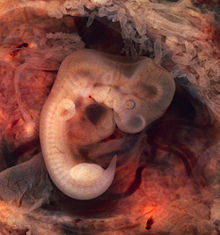In biology, an atavism is a modification of a biological structure whereby an ancestral trait reappears after having been lost through evolutionary change in previous generations. Atavisms can occur in several ways; one of which is when genes for previously existing phenotypic features are preserved in DNA, and these become expressed through a mutation that either knocks out the overriding genes for the new traits or makes the old traits override the new one. A number of traits can vary as a result of shortening of the fetal development of a trait (neoteny)
or by prolongation of the same. In such a case, a shift in the time a
trait is allowed to develop before it is fixed can bring forth an
ancestral phenotype. Atavisms are often seen as evidence of evolution.
In social sciences,
atavism is the tendency of reversion. For example, people in the modern
era reverting to the ways of thinking and acting of a former time. The
word atavism is derived from the Latin atavus—a great-great-great-grandfather or, more generally, an ancestor.
Biology
Evolutionarily
traits that have disappeared phenotypically do not necessarily
disappear from an organism's DNA. The gene sequence often remains, but
is inactive. Such an unused gene may remain in the genome for many
generations.
As long as the gene remains intact, a fault in the genetic control
suppressing the gene can lead to it being expressed again. Sometimes,
the expression of dormant genes can be induced by artificial
stimulation.
Atavisms have been observed in humans, such as with infants born with vestigial tails (called a "coccygeal process", "coccygeal projection", or "caudal appendage"). Atavism can also be seen in humans who possess large teeth, like those of other primates.
In addition, a case of "snake heart", the presence of "coronary
circulation and myocardial architecture [which resemble] those of the
reptilian heart", has also been reported in medical literature. Atavism has also recently been induced in modern avian dinosaur (bird) foetuses to express dormant ancestral non-avian dinosaur features, including teeth.
Other examples of observed atavisms include:
- Hind limbs in cetaceans.
- Extra toes of the modern horse.
- Reappearance of limbs in limbless vertebrates.
- Re-evolution of sexuality from parthenogenesis in orbitid mites.
- Teeth in chickens.
- Dewclaws in dogs.
- Reappearance of prothoracic wings in insects.
- Reappearance of wings on wingless stick insects and earwigs.
- Atavistic muscles in several birds and mammals such as the beagle and the jerboa.
- Extra toes in guinea pigs.
- Reemergence of sexual reproduction in the flowering plant Hieracium pilosella and the Crotoniidae family of mites.
- Webbed feet in adult axolotls.
- Human tails (not pseudo-tails) and supernumerary nipples in humans (and other primates).
- Color blindness in humans.
Culture
Atavism is a term in Joseph Schumpeter's explanation of World War I in twentieth-century liberal Europe. He defends the liberal international relations theory
that an international society built on commerce will avoid war because
of war's destructiveness and comparative cost. His reason for World War I
is termed "atavism", in which he asserts that senescent governments in
Europe (those of the German Empire, Russian Empire, Ottoman Empire, and Austro-Hungarian Empire)
pulled the liberal Europe into war, and that the liberal regimes of the
other continental powers did not cause it. He used this idea to say
that liberalism
and commerce would continue to have a soothing effect in international
relations, and that war would not arise between nations which are
connected by commercial ties.
University of London professor Guy Standing has identified three distinct sub-groups of the precariat, one of which he refers to as "atavists", who long for what they see as a lost past.
Social Darwinism
During the interval between the acceptance of evolution in the mid-1800s and the rise of the modern understanding of genetics
in the early 1900s, atavism was used to account for the reappearance in
an individual of a trait after several generations of absence—often
called a "throw-back". The idea that atavisms could be made to accumulate by selective breeding, or breeding back, led to breeds such as the Heck cattle. This had been bred from ancient landraces with selected primitive traits, in an attempt of "reviving" the aurochs, an extinct species of wild cattle. The same notions of atavisms were used by social Darwinists, who claimed that inferior races displayed atavistic traits, and represented more primitive traits than other races. Both atavisms and Ernst Haeckel's recapitulation theory are related evolutionary progress, as development towards greater complexity and superior ability.
In addition, the concept of atavism as part of an individualistic
explanation of the causes of criminal deviance was popularised by the
Italian criminologist Cesare Lombroso in the 1870s.
He attempted to identify physical characteristics common to criminals
and labeled those he found as atavistic, 'throw-back' traits that
determined 'primitive' criminal behavior. His statistical evidence and
the closely related idea of eugenics
have long since been abandoned by the scientific community, but the
concept that physical traits may affect the likelihood of criminal or
unethical behavior in a person still has some scientific support.

